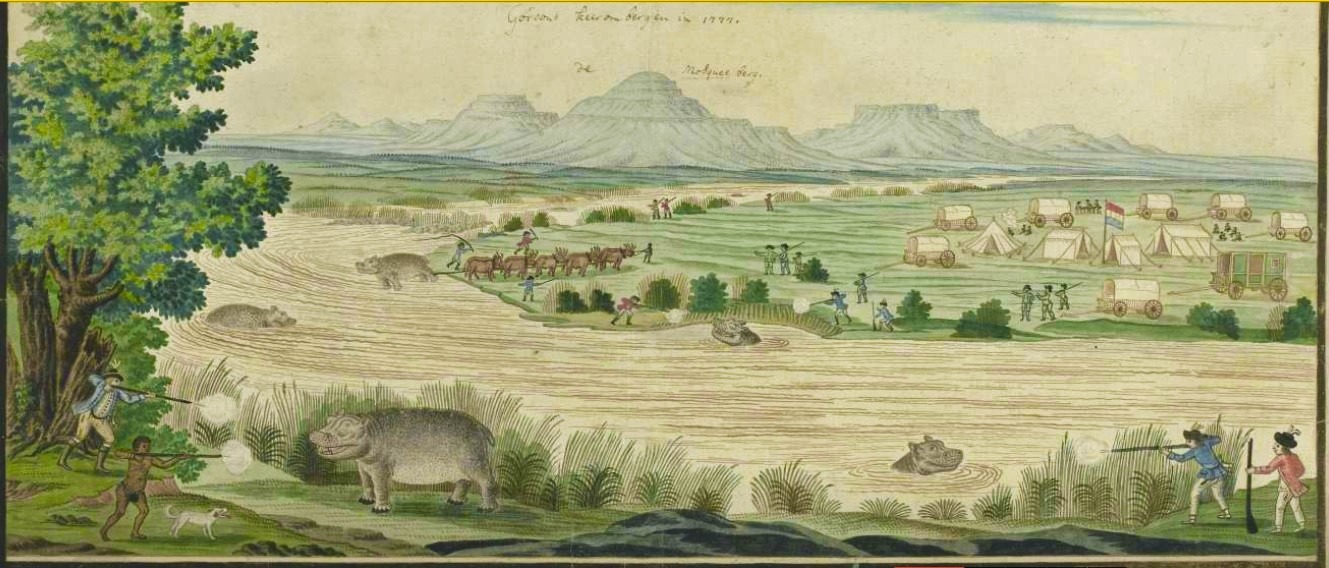Looking out over the peaceful Seekoei River, the reeds swaying in the breeze, I find it hard to fathom the horrible atrocities that happened here almost 250 years ago. On 23 September 1775, colonial explorers Robert Jacob Gordon and Baron Joachim Ammena van Plettenberg from Netherlands shot and killed as many as 26 hippo in one day on the Seekoei River (meaning Hippo River) that runs through the semi desert Karoo region of the Northern Cape of South Africa. A 1777 painting by RJ Gordon portrays one such hunting party in full flagrant sway. French explorer François le Vaillant writes at the end of the 18th century about how he fashioned a plate from the foot of a hapless hippo.

About 230 years later, PC Ferreira, a passionate sheep farmer and the heart behind the KhoiSan Karoo Conservancy, realized the immense loss to the environment and conservation, suffered generations ago, when the last Seekoei River hippos were shot and killed in the late 1700’s. These were the last remaining hippos in the Karoo and the Northern Cape. PC decided to take action and initiated a hippo reintroduction project in 2000. It would eventually take 6 years for this project to bear fruit, but in 2006 a small breeding group of hippos were released on the then recently established Karoo Gariep Conservancy (est. 2005). Now known as KhoiSan Karoo Conservancy, which includes the formally proclaimed Karoo Gariep Nature Reserve (est 2015) and Hanover Aardvark Nature Reserve.


For his contribution to conservation PC was awarded the SANParks Kudu Award in 2008. We are raising funds to introduce three hippo cows and re-establish a healthy hippo family in the Seekoei River in the Karoo Gariep Nature Reserve. This hippo family will be the only hippo family in the Northern Cape. In time our goal is to establish a viable wild hippo population all along the Seekoei River, which is 300 km in length and can accommodate at least 80 hippos. Our goal is to restore the Seekoei River valley to its pristine, wild and natural state so that wildlife and humans can thrive together and prosper. You can help us by donating to this worthy conservation cause.
The Big Dream…
The Karoo Wildlife Conservation Project vision came about after the success of the wildlife re-introduction program and proclamation of the Karoo Gariep Nature reserve. PC figured, why stop there, why not have the entire Seekoei River as a conservation area? This ambitious initiative will encompass an area of 450,000 hectares, from Kompasberg (near Nieu Bethesda) in the south all along the Seekoei River to the Doornkloof Nature Reserve where the river flows into the Vanderkloof Dam. This initiative is in partnership with the Northern Cape Department of Environment and Conservation (DENC), and the first phase of the project, consisting of five private landowners working together (representing 35 000 hectares) is well under way towards formal proclamation!

Biodiversity is in trouble globally. We need to do everything we can to rewild areas that were once wildlife havens. The Karoo Wildlife Conservation Project is one such opportunity. Nature provides so much for us on a daily basis, we cannot survive without nature and healthy functioning ecosystems. You can help us rewild the Karoo and give back to nature by contributing to the Karoo Wildlife Conservation Project.

